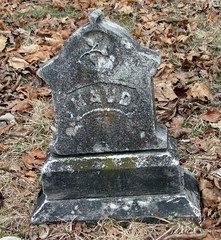February Footstone Project; Blog Post #5
You can see that this is not a footstone but the grave of a small child. But, it is the size of a footstone and without the gravestone next to it identifying her as a daughter, we would not even know what her last name was.
Little Maud BRADBURY, born 1880 and died in 1881, is the subject of this tiny baby granite gravestone. It has the drooping bud of a flower to indicate a life not yet lived. (mortal life unblossomed; renewal in the afterlife [Carmack p. 221])
She is resting next to her parents and grandparents in the cemetery closest to my home. I took this photo and those of her parents and grandparents because of an email this week from a man who used to live in Bridgewater, whose surname is Wheeler. As I have Wheeler's in my family, he wondered if we were related.Before it snowed yesterday, I drove to the cemetery with my camera and looked for these graves. I drive by here every day.
I asked him about the graves in this cemetery which is called Prattown or Orange St. Cemetery.He told me that one of his brick walls was Maud's sister, Ella May Bradbury who was divorced from her first husband.
I was delighted to help him out with his Bradbury problem and I learned a new skill when I went in search of Little Maud's dates of birth and death. The link to Maud's death record for 1881 at NEHGS was incorrect and led me to a listing of people who died at the State Workhouse in the MCI. So, I returned to the search box and cleared the results.
I searched for Bridgewater deaths in Volume 329 Year 1881 hoping that the results would yield all people who died in Bridgewater that year. It did! So, I looked backwards from page 295, which was wrong to get to page 293 to find her date and cause of death. It took looking at someone else's death to find little Maud.
Maud was born in Bridgewater on 10 Oct 1880 (Vital Records of Bridgewater 1841-1910, 314:323) and died of cholera infantum on 7 Sept. 1881. (Vital Records of Bridgewater 1841-1910, 329:293) She was 10 months and 26 days old. Very sad.
Carmack's book (p. 236) states that this disease was common and a non-contagious diarrhea of young children called summer complaint occurring in summer or early fall in hot weather. Death occurred in three to five days.


No comments:
Post a Comment